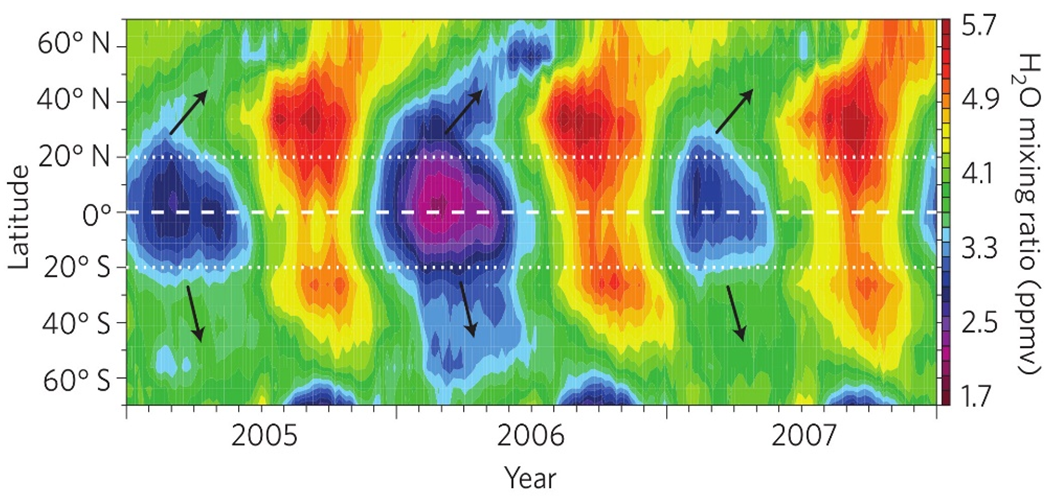SouthTRAC

Transport and Composition of the Southern Hemisphere UTLS
Mission status: Completed
Mission Website:
Persons in Charge
Mission-PI
Markus Rapp (DLR-IPA)
Mission coordinator
- Martin Riese (FZ Jülich)
- Peter Hoor (Univ. Mainz)
- Björn-Martin Sinnhuber (KIT)
- Andreas Engel (Univ. Frankfurt)
HALO Deployment Base
Time Period
July 2019 – December 2019
| Mission phase | Dates |
|---|---|
| Preparation, payload integration, EMI testing | 22 Jul - 6 Sep 2019 |
| Mission execution, phase 1 | 9 Sep - 9 Oct 2019 |
| Instrument maintenance | 10 Oct - 2 Nov 2019 |
| Mission execution, phase 2 | 3 Nov - 25 Nov 2019 |
| Dismounting of payload | 26 Nov - 2 Dec 2019 |
Project description
Changes in the distributions of trace gases, like water vapour and ozone, and thin cirrus clouds in the upper troposphere and lower stratosphere (UTLS) impact radiative forcing of the Earth’s climate and surface temperatures, and are key for understanding climate change. Due to the high sensitivity of atmospheric radiative forcing to changes in greenhouse gases in the cold tropopause region, even small variations, for example, in water vapour in the lower stratosphere, are an important source of the decadal variability of the surface temperature. There is also large uncertainty in future changes of ozone and water vapour in the UTLS, limiting the ability to predict the radiative forcing due to stratospheric ozone recovery and related processes during the 21st century have shown that different chemistry climate models do not even agree on the sign of radiative forcing due to ozone recovery because of large uncertainties in modelled ozone changes in the vicinity of the tropopause.

Figure 3.19: Satellite observations (AURA-MLS) showing transport of H2O at the 390 K isentrope from the tropics to the Arctic
The project Transport and composition of the Southern Hemisphere UTLS (South- TRAC) is a HALO mission carried out in late 2019 (completed in November) to explore the UTLS of the Southern Hemisphere. SouthTRAC was based in Rio Grande (Tierra de Fuego, Argentina). Next to UTLS aims, SouthTRAC also explored gravity waves and their influence on the middle atmosphere up to an altitude of about 80 km. Here we briefly report on the results concerning the dynamics and chemistry of the Southern Hemisphere UTLS with special emphasis on the influence of the Antarctic polar vortex, of isentropic exchange between lower stratosphere and upper troposphere, and of emissions from biomass burning. These investigations are expected to enhance the understanding of the differences of these phenomena and of chemical composition of the UTLS between the two hemispheres. As an example for the strong hemispheric differences in transport and radiatively important gases, the annual variation of the zonally averaged latitudinal distribution of water vapour is shown in Figure 3.19. The Antarctic winter 2019 was very special, as it was marked by a warming event occurring in September 2019. This warming led to higher temperatures than average in the Antarctic polar vortex and at higher altitudes a reversal of wind direction. Therefore, the data gathered during SouthTRAC provide a view on a winter with unusual meteorology and comparatively little ozone depletion and also unusual conditions for the propagation of gravity waves in the middle atmosphere
HALO was equipped with a payload largely based on the successful WISE and PGS campaigns. One major difference was the exchange of the WALES lidar, which provided H2O and O3 distributions with the temperature lidar ALIMA providing information up to the mesosphere. Measurements of a wide variety of different trace gases, with different lifetimes and different source-sink characteristics are available from SouthTRAC in a region of the atmosphere that has so far been studied much less intensively than the Northern Hemispheric counterpart. Scientific questions related to chemical processes (ozone loss, halogen budget, biomass burning influence and to dynamical processes (isentropic exchange and mixing, gravity waves) will be investigated. The focus will be on halogen distribution and chemistry, long range transport of biomass burning polluted air and on isentropic mixing comparing the Northern and Southern Hemispheres.

Figure 3.20: Tracer time series from the GhOST-MS instrument of University Frankfurt for flight ST13 of SouthTRAC on September 24, 2019 (left) and CLaMS forecast of mean age of air with overlaid flight path of HALO (right, plot produced using the HALO MSS tool). A filament of high mean age is modelled to the North-West of the Islas Malvinas. This filament was not visible in ECMWF analysis but a corresponding structure was found in the observations.
Four main scientific topics (ST) were identified. These are linked to dynamics (DYN) and chemistry (CHEM) of the Southern Hemisphere:
- ST-DYN1: Transport and mixing processes in the SH-UTLS
- ST-DYN2: Gravity waves in the SH-UTLS
- ST-CHEM1: Impact of the Antarctic vortex on the SH-UTLS
- ST-CHEM2: Influence of biomass burning and biogenic emissions on the SH-UTLS
At the time of writing of this proposal, the SouthTRAC campaign was just completed, so only some preliminary results can be shown here. One exceptionally clear result was that also at flight altitudes of the HALO aircraft significant ozone loss was observed. This ozone loss was also visible in aged air masses from the polar vortex, which had been transported to the mid-latitudes of the Southern Hemisphere. Figure 3.20 shows measurements of long lived gases and ozone in a filament of vortex air, which was peeled of the polar vortex. This filament was projected by the Lagrangian CLaMS model, but was not visible in ECMWF analysis data. The very sharp filament is observed in long-lived tracers (red and blue lines) but not in ozone (green line) indicating that ozone depleted air is transported to the mid-latitudes. The chemical depletion of ozone has also been observed in correlations between N2O as a long lived-tracer and ozone (Figure 3.21). The data in the upper right part of the diagram (red data points) show what is expected under unperturbed conditions (increasing ozone with decreasing N2O).

Figure 3.21: Correlation of N2O (UMAQS, University Mainz) versus ozone (FAIRO, KIT) for SouthTRAC flights during phase 1 during which vortex air was encountered. Different colours indicate different flight dates. Deviations from the compact relationship of ozone and N2O clearly indicate significant chemical ozone loss. Loss processes might have occurred partly inside the vortex and depleted air masses were subsequently transported down to measurement altitudes where they mix with unperturbed mid-latitude air.
Partners
- German Aerospace Center, Institute of Atmospheric Physics (DLR-IPA)
- Forschungszentrum Jülich
- Karlsruhe Institute of Technology
- Johannes Gutenberg University Mainz
- Goethe University Frankfurt
- Heidelberg University
- University of Wuppertal
- PTB Braunschweig (National Metrology Institute)
Scientific instruments and payload configuration
List of scientific instruments for the mission:
| Scientific instrument acronym | Description | Principal investigator | Institution |
|---|---|---|---|
| GLORIA | Gimballed Limb Observer for Radiance Imaging of the Atmosphere | Felix Friedl-Vallon Peter Preuße | KIT FZ Jülich |
| ALIMA | Iron Resonance Lidar | Bernd Kaifler | DLR-IPA |
| miniDOAS | Differential Optical Absorption Spectroscopy | Klaus Pfeilsticker | Univ. Heidelberg |
| HALO_AIMS | Differential Optical Absorption Spectroscopy | Christiane Voigt | DLR-IPA |
| FAIRO | Fast ozone measurement | Andreas Zahn | KIT |
| FISH | Fast In-situ Stratospheric Hygrometer | Martina Krämer | FZ Jülich |
| GhOST | Gaschromatograph for Observation of Stratospheric Tracers | Andreas Engel | Univ. Frankfurt |
| HAI | Hygrometer for Atmospheric Investigations | Volker Ebert | PTB |
| HAGAR | High Altitude Gas AnalyzeR | Michael Volk | Univ. Wuppertal |
| IPA-NOY (AENEAS) | NOY measurement | Helmut Ziereis | DLR-IPA |
| KIT-Dropsondes | Multi-Sonde System for Meteorological and Microphysical Measurements | Andreas Wieser | KIT |
| TRIHOP | TRacer In-situ quantum cascade laser absorption spectrometer/ Hydrogen and Organic Peroxide monitor | Peter Hoor | Univ. Mainz |
| BAHAMAS | HALO Basic Data Acquisition System | Andreas Giez | DLR-FX |
Cabin and exterior configuration of HALO for the mission
HALO flights for this mission
| Aircraft registration | Date | Take off - Landing / UT | Total flight time / h | From - To | Mission # |
|---|---|---|---|---|---|
| D-ADLR | Date | hh:mm:ss - hh:mm:ss | h | CODE - CODE | 1 |
| D-ADLR | Date | hh:mm:ss - hh:mm:ss | h | CODE - CODE | 2 |
| D-ADLR | Date | hh:mm:ss - hh:mm:ss | h | CODE - CODE | 3 |
| D-ADLR | Date | hh:mm:ss - hh:mm:ss | h | CODE - CODE | 4 |
| D-ADLR | Date | hh:mm:ss - hh:mm:ss | h | CODE - CODE | 5 |
| D-ADLR | Date | hh:mm:ss - hh:mm:ss | h | CODE - CODE | 6 |
| D-ADLR | Date | hh:mm:ss - hh:mm:ss | h | CODE - CODE | 7 |
| D-ADLR | Date | hh:mm:ss - hh:mm:ss | h | CODE - CODE | 8 |
| D-ADLR | Date | hh:mm:ss - hh:mm:ss | h | CODE - CODE | 9 |
| D-ADLR | Date | hh:mm:ss - hh:mm:ss | h | CODE - CODE | 10 |
| D-ADLR | Date | hh:mm:ss - hh:mm:ss | h | CODE - CODE | 11 |
More information
Press releases, media etc
- SOUTHTRAC in the Helmholtz-Blog: https://blogs.helmholtz.de/on-tour/2019/09/
- SOUTHTRAC-Blog from FZ-Jüich: https://blogs.fz-juelich.de/climateresearch/category/southtrac/
- SOUTHTRAC-Blog from JGU Mainz: https://www.ipa.uni-mainz.de/2019/08/23/southtrac-2019/
- Blog from accompanying campaign with a Stemme airplane in Patagonia: https://www.pa.op.dlr.de/southtrac/html/soaring/index.html
- Youtube clips from KIT:
- Atmosphärenforschung zwischen Deutschland und Feuerland – die SouthTRAC-Kampagne: https://www.youtube.com/watch?v=J5tfv3W69l4
- Forscheralltag: Ein Tag auf SouthTRAC-Kampagne: https://www.youtube.com/watch?v=gnIi19gEPAE
- Inside SouthTRAC: Team Gloria: https://www.youtube.com/watch?v=yq3JjVhuAFI
- KITSonde: Multi-Sensor-Fallsondensystem für hoch aufgelöste Messungen: https://www.youtube.com/watch?v=P6pJ7qIyUAc
- Campaign photos on Flickr: https://www.flickr.com/photos/dlr_de/albums/72157710822623062/with/48951608082/https://www.flickr.com/photos/dlr_de/albums/72157710822623062/with/48951608082/
